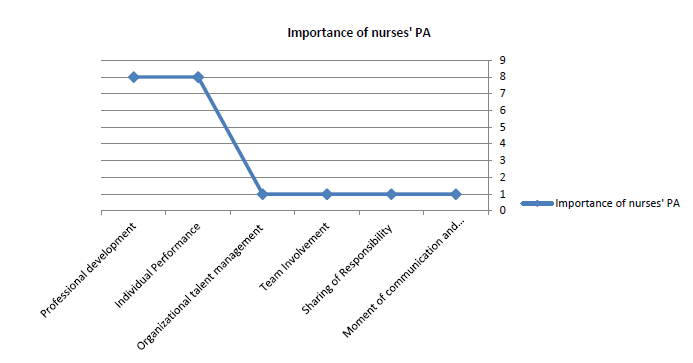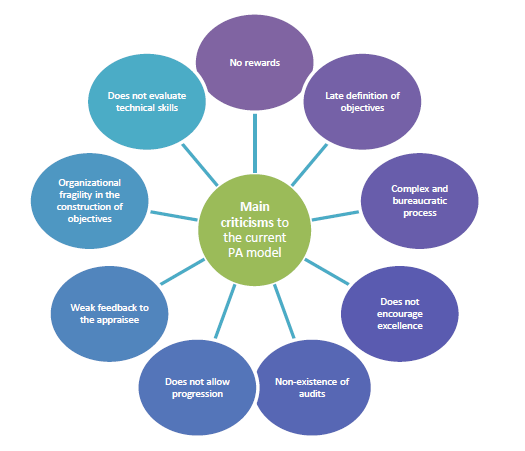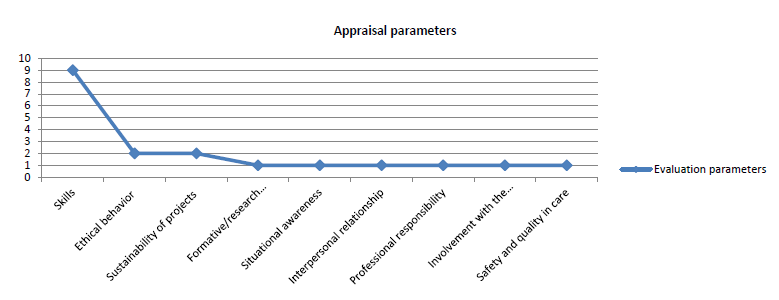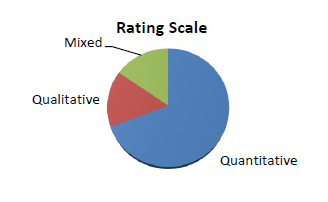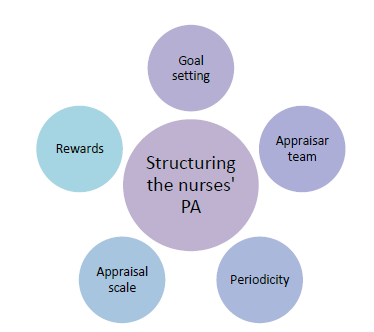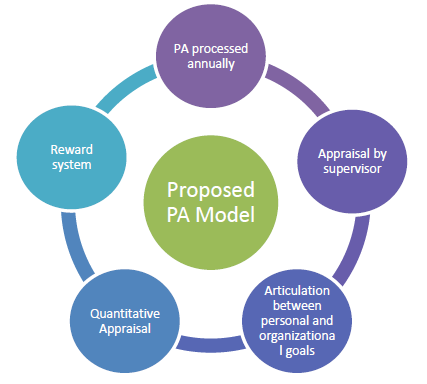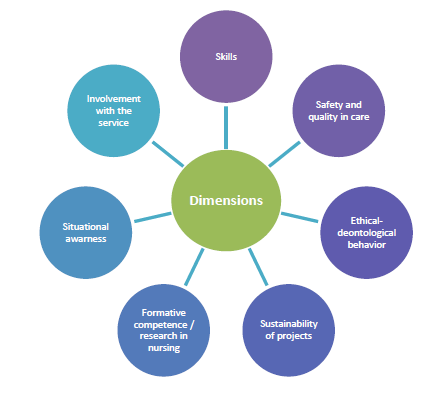Introduction
In today's global world, which is increasingly competitive and with high technological evolution, it is essential to assess nurses' performance in a fair and effective way. According to Romero (2019), nurses are the key to the development and evolution of organizations, being the differentiating and decisive element for organizational success. Therefore, it is essential that people who participate in organizations feel as an integral part of it and, consequently, collaborate with the organization to achieve the defined objectives, both for the organization and for themselves (Cardoso, 2016).
Organizations should be places where people are treated with respect and dignity and where they are encouraged and empowered to contribute to a joint development. In this sense, it is important to evaluate the performance of employees, and it is necessary to develop a fair, accurate and motivating performance appraisal (PA) system, and not only just a bureaucratic system with a mandatory nature (Faraji et al., 2015; Hwang & Lee, 2019).
An organization's PA system can be a practical and useful tool for managing employee motivation and development when employees perceive it to be accurate and fair (Thurston & McNall, 2010; Carbone et al., 2016). For these authors, organizational justice can create powerful benefits for organizations and their employees, including increased trust and commitment, improved performance, organizational citizenship behavior, customer satisfaction, and decreased conflict.
New perspectives have emerged for the public service, including nurses as special corps, with the current Integrated System for Performance Evaluation of the Public Administration (SIADAP) created by Law no. 10/2004 of March 22 and regulated by Decree-Law no. l9-N2004, in Portugal.
According to national government entities, the current performance evaluation system (SIADAP) is an instrument for developing the strategy of public organizations and one of the most important tools for managing human resources. It is a new management culture based on a logic by objectives that, if properly used, will allow identifying functional imbalances, organizational deficiencies, making staff and managers accountable, and creating a demanding, meritocratic, and transparent climate.
Nurses are a key element in any health care organization, so, PA should be used as a motivating force for improving their performance, with a view to achieving personal satisfaction, the satisfaction of clients and their families, and the satisfaction of the organization, thus contributing to the continuous improvement of the quality of care.
Therefore, the general objectives were defined as follows: to identify which elements should be included in the nurses' framework and identify good practices on this process. The secondary objectives were: to understand, in the interviewees' opinion, the importance of PA; to understand the main criticisms to the current performance model for nurses.
1. Theoretical framework
With the evolution of the world and of humanity, we are currently facing a strategic management of human resources. Evaluating the performance of employees means promoting the sustained strategic success of the organization, not only by improving the behavior of its members, but also by improving organizational, technological and procedural aspects (Bohlander and Snell, 2015; Burmester, 2017).
For some authors, PA boils down to a mere bureaucratic process with little practical applicability or to an always satisfactory assessment that allows career progression and that does not reward merit or excellence, considering everyone equal (Oliveira, 2006). For others, it is a system with potential and aims at professional improvement, which will allow for the creation of a motivated, dynamic and committed "workforce", because nurses are not only people: they are key resources for value creation (Faraji et al., 2015; Hwang and Lee, 2020).
PA is a systematic assessment of nurses' professional practice and their potential for self-improvement to determine the value, excellence, and capabilities of nurses in their practice (Freitas, 2017) and is a cornerstone of any effective human resource management system (Bohlander and Snell, 2015).
According to Caetano (2008b), the formal objectives of PA systems are to: align the employees' activities with the organization's strategic objectives; improve performance, productivity, and motivation; increase the organization's sustainability; provide feedback and advice to employees on their performance and career; provide a basis for deciding on incentives, rewards, progressions, promotions, resignations, and terminations; and identify training needs. Thus, according to the same author, the objectives of PA can be conceptualized in three broad categories; those aimed at maintaining and developing the organization, those focused on individual development and those focused on reward management (Caetano, 2008a). In relation to the appraisees, they usually have three types of objectives concerning their PA, namely: to obtain feedback about their performance and comparatively to their colleagues; to have information for guidance on their future career path; and to know what the ideal standard of performance is (Bilhim, 2009).
Both the instruments and the sources of PA are important for organizations, with regard to the ease or difficulty of applying the assessment, its effectiveness and acceptance by all stakeholders (Caetano, 2008a). Thus, it is necessary to implement assessment instruments that promote professional growth and are motivators of performance improvement, so that the information obtained during the performance assessment can be used for the development of the employee's potential, allowing to help the employee in overcoming the difficulties experienced in the performance of his/her role, to identify the strengths of which he/she is not aware and to help set the goals (Marquis and Huston, 2015).
According to Caetano (2008a, 2008b) and Marquis and Huston (2015), the most commonly used assessment instruments in organizations can be focused on: behaviors - critical incidents, forced choice scales, behaviorally anchored scales, mixed pattern scales, behavioral observation scales, and checklists; results - performance standards and management by objectives; personality - scales anchored in personality traits; and comparison of the appraisee with other employees - pairwise comparison, forced distribution, and simple ordering.
With regard to PA, we must first properly identify the skills of each nurse according to their level of expertise, since only with the accurate identification of these skills can their performance be correctly assessed (Bolander and Snell, 2015). Others authors advocate the need for a salary grid that reflects the nurses' development in terms of skills, promoting the differentiation between beginners and experienced nurses, so as to motivate the professionals themselves to engage in their professional development and perform at a high level (Carbone et al, 2016; Freitas, 2017; Romero, 2019).
In Portugal, the current appraisal mechanism is the Integrated System for Management and Performance Evaluation in the Public Administration (SIADAP), which appears as a new paradigm for PA of workers in public sector bodies and institutions (Art. 2 of Law No. 66-B/2007). It is divided into three performance assessment subsystems: SIADAP 1 (Performance assessment system of organisms); SIADAP 2 (Performance assessment system of managers); SIADAP 3 (Performance assessment system of workers), the latter being applied to nurses. Although SIADAP is only in force in the public service, it is an important contribution to other organizations, private or third sector.
It is a comprehensive system that, despite being dynamic, is also demanding in terms of its internal organization and implementation on the ground. The appraisal of employees and managers begins to focus on two components - results and competencies, which will have a variable weighting according to previously fixed rules and little flexibility. The establishment of objectives and competencies is based on a system of negotiation between the evaluator and the evaluated, as in the previous model, with the evaluated having to perform a self-assessment. It allows for the awarding of mentions of Outstanding Performance and Excellent Performance with the need to comply with pre-defined quotas, and with the involvement of the Council for Coordination of Evaluation. In addition, there is a Joint Committee in which management and employees are represented as a consultative body that works closely with the top manager and to which employees may appeal in the event of disagreement with the appraisal intended for them.
The appraisal envisaged in SIADAP leads to the differentiation of merit in performance. It is important to differentiate those who strive to create synergies that end up influencing others or creating innovation, despite the much criticized appraisal for Relevant and Excellent. The SIADAP appraisal is mandatory, and it is essential to negotiate the results between the appraisal and the appraisee, defining the objectives, measurement indicators and overcoming criteria, as well as the competencies that are expected to be achieved.
However, this process is recognized as a major obstacle to the implementation of SIADAP: the lack of involvement of the top of the organizational structures of the Public Administration. It is an undemocratic appraisal model (if there is no agreement between the appraisee and the appraiser, the objectives may be imposed) and very bureaucratic.
Although the objectives may be imposed, when there is no agreement between the appraiser and the appraisee, at the very least, the professional project that the appraisee has for his career, the main axes of professional development, the training required to fulfill the tasks assigned. In other words, the management of the employee's career must be taken into account. The appraisal cannot, furthermore, be disconnected from the conditions in which the work is performed (the conditions of organization and operation of the service), the demands of the activities, the appreciation of unforeseen events or events (activities that are not defined in the framework of the objectives but that translate into a significant investment by the worker to meet them), and the means that are placed at the disposal of the worker to meet the objectives.
The appraisal is based on previously defined criteria that allow the appraiser's performance to be classified. This appraisal should be done taking into account the objectives set, and should be negotiated with the appraisee (Bojlander and Snell, 2015; Camara et al., 2016).
As a rule, the appraisal is performed by the hierarchical superior, as it is considered "that this is the one who has the legitimate position to do so" (Caetano and Vala, 2002:375). However, according to the same author, the appraisal can also be performed by other actors such as the self-appraisal, the colleagues of the evaluated person who belong to the same area where the evaluated person works, who have the same hierarchical level and who work directly with the individual, and also the subordinates, and several evaluators can be included - 360º aappraisal.
According to Camara et al. (2016) the reward system is a strategic human resource management practice that promotes the alignment of employees' objectives with the company's strategic objectives. This system is interconnected with other human resource management practices, mainly with the PA system.
These rewards can be material and immaterial, fixed or variable, in cash or in kind (Camara et al., 2016). Recognition of the work done is important, whether in the form of more responsibility or promotions, or in the form of awards and other ways of giving visibility and importance to the employee's contribution. This makes employees feel more motivated and satisfied.
According to Varela (2017) one of the ways to design a good reward system is to give employees the opportunity to participate in the design of the reward system to be applied, thus having an active participation in the decision making about the rewards they wish to receive. This can produce a strong sense of organizational justice and consequently greater job satisfaction.
To motivate and satisfy their human resources, companies have to take into account not only salary rewards, but also recognition rewards and development opportunities, for example. For Camara et al. (2016) training nowadays assumes a fundamental role in the life of companies, insofar as they have to be able to keep up with and respond to the demands of the labor market. Some consider it as a merely mandatory component with which they must comply, but there are also those who see it as a way to invest in the potential of their human resources and qualify them so that they can ensure quality in professional performance, thus contributing not only to individual goals, but also to organizational goals (Camara et al., 2016; Burmester, 2017).
The PA is also a source of diagnosis of training needs because it is undoubtedly essential to develop skills and adapt workers to the transformations and changes that arise naturally (Bilhim, 2009; Cardoso, 2016).
2. Methods
This is a descriptive exploratory study, with a qualitative approach.
Intentional sampling was used, which is a non-probability sampling method subject to the researcher's criteria, the researcher's criteria being nurses from the public, private and social sectors, regardless of experience as evaluators.
Sample
The sample included nurses from the public, private and social sectors, with or without experience as evaluators, in a total of 12 interviewees. Data collection was carried out using semi-structured interviews.
Data collection instruments and procedures
Data were collected between September 1, 2021 and October 31, 2022, and subjected to content analysis according to Bardin (1995).
Ethical issues were ensured through the approval of the interview script by the respective ethics committee and the consent of each interviewee to participate in the study, ensuring the right to anonymity and data confidentiality. The interviews were recorded with the interviewees' permission.
The interview script was structured in two parts, with the first part corresponding to the characterization of the sample, and the second part to the set of questions asked to the interviewed experts, which guided the creation of categories (Table 1).
After the interviews, the information was processed and the answers were fully transcribed for further analysis. The information was selected and what proved to be relevant to the research problematic was extracted. After that, we proceeded to the interpretation and analysis of the selected information and to the discussion of the same.
Data were analyzed through content analysis and categories and subcategories were developed based on the questions in the interview guide.
3. Results
With regard to the objective "To understand the importance of the nurses' appraisal", the participants highlighted the importance of the PA for the professional development of the appraisee and the promotion of individual performance, as shown in Chart 1. They also highlighted other aspects, such as the influence and importance for organizational talent management, the sharing of responsibility between the appraiser and the appraisee, and the fact that it is an official moment of sharing and discussion between both.
Regarding the main criticisms of the current model, it is worth mentioning the fact that it is too complex and bureaucratic, that it does not encourage excellence, with late definition of goals, with no associated reward system, that it does not allow for career progression, with organizational weaknesses in the construction of goals, the lack of audits and the inoperability in the appraisal of technical skills (Diagram 1).
With regard to the assessment parameters, the subcategory "Skills" was the one that stood out in particular (See Chart 2). Other aspects were mentioned such as: the assessment of safety and quality provided, ethical and deontological behavior, participation and sustainability of projects, collaboration in research, assessment of situational/self-awareness.
Regarding the structuring of the PA, the participants referred to several domains, namely:
Goals: should be defined between evaluator and evaluated, and articulated the personal ones with the organizational ones (12 ru - registration unit);
Appraisal team: 8 participants mentioned that the supervisor should evaluate, 3 participants mentioned that the appraisal should be performed by the supervisor and peers, and 1 participant mentioned that the appraisal should be performed by the supervisor, peers, other professionals and patients;
Appraisal period: annual (8ru);
Rating scale: quantitative (10ru) - see chart 3;
Rewards: must have an associated and previously defined reward system (12ru).
4. Discussion
In the category Importance of the nurses' PA, the contribution to professional development and its influence on individual performance stood out. These results corroborate the author Lino (2020) when he states that the PA allows measuring the individual contribution of each employee towards the organisation's productivity, allowing for the identification of points for improvement and the promotion of know-how. Also Caetano (2008b) states that PA is seen as a process that aims at improving the performance of employees, contributing, in a positive way, to the development of the organization's economic and social sustainability.
There is a growing trend towards increasing the value placed on the human factor in organizations. The role played by employees has nowadays taken a prominent position in the organizational environment. However, companies are not only looking for people to complete their team, but for professional talents with potential and skills that allow them to develop and grow. People who identify with the mission, vision, organizational values and objectives are today a decisive part of business success (Lino, 2020). Also for Bohlander and Snell (2015) and Silvério (2017), the most valuable asset of a company is its intellectual capital, for the growth of the organization that must begin with the development of its professionals. Thus, the importance of not only having people performing a function, but also professionals who stand out, and who have the ability to add value to the company, through the improvement of human capital, is verified.
The appraisal moment assumes itself as a measure created by the organization that will allow a closer contact with the employees, in order to obtain a notion of their performance, thus allowing to measure productivity levels, identify problems and difficulties that may be detrimental, establish the expected results and provide a monitoring of workers in their functions, without the intention of the search and censorship of weak points. According to Aguinis, Gottfredsib & Joo (2012), the moment of appraisal is an official moment of feedback given to employees, as emerged in this study, and this aspect is assumed as a very important variable for the increase of motivation, satisfaction and interpersonal relationships within the organization.
Some authors advocate feedback as mandatory in this process so that the assigned appraisals are justified, providing the employee with the opportunity to perceive the positive aspects and those which should be improved (Aguinis, Gottfredsib, & Joo, 2012; Romero, 2019).
In the category Criticism of the current model in force, several dimensions emerged, which reflect the current dissatisfaction with the model currently in force for nurses' PA. The lack of preparation for this system, the lack of rigor and the absence of rewards lead, in general, to a general discontent and demotivation, which make the implementation of this PA a compulsory and frustrating process.
The study of Pereira and Moreira (2015) reveals the sense of injustice felt by the appraisees, with consequent demotivation and dissatisfaction associated with the current appraisal system, which in turn is associated with poor accuracy of the assessment, the non-differentiating quotation of performance and merit, the lack of definition of objectives that are not consistent, with consequent unfair measurement and lack of adequate and regular feedback. Lino (2020) highlights the emphasis placed on results and the limitations that exist with the use of a quota system.
In the category Elements that should be included in the nurses' performance appraisal framework, the subcategories technical, relational and theoretical skills, ethical and deontological behavior and project sustainability emerged. Other subcategories emerged, such as: Training suitability/nursing research; Self-awareness/Situational awarness; Interpersonal relationships; Professional responsibility; Involvement with the service/ dedication to the cause; and Safety and quality of care.
According to Bilhim (2009), PA should take into account not only quantitative, but also qualitative aspects, taking into account the mix between results and goals, behavioral and personality aspects.
Note that performance management should be a continuous process of interaction, and can be considered a cycle. In this cycle, as described by Nascimento and Pereira (2015), there is a set of phases that should exist, namely the performance planning phase (in which the objectives and measurement indicators are established), the execution and monitoring phase, the PA phase, and the appraisal review and new planning phases.
In the last category, structuring of the nurses' PA, the following subcategories stood out (Diagram 2):
In the subcategory Goal setting, all participants mentioned that personal goals should be set in accordance with the organisational goals, which corroborates the literature consulted, namely Caetano (2008b), when he states that the main objectives of the PA are the alignment of the employees' activities with the strategic objectives of the organisation, leading to improved performance, increased productivity and motivation, and increased sustainability of the organisation.
In relation to the Appraiser Team subcategory, the appraisal tends to be done by the direct supervisor (Cardoso, 2012); according to Chiavenato (1998), the supervisor is the individual who has the best characteristics to analyze the appraisee's performance, and this was evident in the interviews conducted. The literature consulted recommends that the appraiser should have close contact with the appraisee (Rodrigues, 2005; Cardoso, 2012). Cunha et al. (2010) argue that the appraisal should be processed using different evaluators, namely the direct supervisor, peers, the human resources technician, self-assessment, and clients. Massingham, Thi and Massignham (2011) advocate the 360º appraisal, which consists of using different sources simultaneously.
Regarding the subcategory Periodicity, no evidence was found in the literature as to the ideal period of appraisal, but Rodrigues (2005) and Cardoso (2016) highlight the need to define short, medium, and long-term objectives.
In the subcategory Appaisal Scale, although most participants advocated the quantitative method for appraisal, Silva (2019) argues that PA should be done taking into account not only quantitative aspects, but also qualitative aspects. For Bohlander and Snell (2015) and Carbone et al (2016), PA should be a mix of results and goals, behavioral aspects, and personality aspects.
Finally, in the subcategory Rewards, monetary rewards, vacation days, career progression, and training were the most prominent. These aspects are in line with the literature consulted, namely Silva (2019) states that in order to motivate and satisfy their human resources, companies must not only take into account salary rewards, but also recognition rewards and development opportunities, for example. Although many people immediately associate rewards with salary components, today we know that there are many other ways to reward an employee, one of them being training. Nowadays, training assumes a fundamental role in the life of companies, to the extent that they have to be able to keep up with and respond to the demands of the labor market (Silva, 2019). There are those who consider it as a merely mandatory component with which they have to comply, but there are also those who see it as a way to invest in the potential of their human resources and qualify them so that they can ensure quality in professional appraisal, thus contributing not only to individual goals, but also to organizational goals. In addition to these perspectives, we can then resize training as a source of reward for an employee's performance. We believe that this is a differentiating factor because it bets and expands the worker's capabilities, being an added value for the worker due to the position that training has been occupying.
Considering what was presented above, we propose a PA model that is processed annually, with appraisal performed by the supervisor, based on a policy of defining personal goals articulated with organizational goals, with a quantitative appraisal scale and an associated reward system (see diagram 3).
The dimensions to be evaluated would be: technical, relational and theoretical skills, safety and quality of care, ethical behavior, participation in sustainability and research projects, situational and self-awareness, and engagement with the service - diagram 4.
Conclusions
PA has a prominent role in human resource management, with direct repercussions on productivity as a process of performance control, but also, indirectly, as a process of professional development, training, promotion, and remuneration, and, in this context, be a determining factor for the organization's success. PA should be well planned between managers and employees from the beginning, with clear objectives, known and accepted by both parties. The same applies to the skills to be assessed, which should be known and agreed upon by those involved in the process.
Organizations today are perceived as a social reality with values, beliefs, and standards of action shared by its members, so the PA system of an organization plays a key role in determining the type and value of the organization's culture. Likewise, PA allows checking individual and organizational productivity, reconsidering technologies, materials and work procedures, among others, and has the major purpose of raising the effectiveness, effectiveness and efficiency of an organization.
In this sense, the proposed model aims to be a strategic process, used with the objective of involving the appraisee and creating commitment and involvement in the appraisal process in order to improve the organization's results by improving individual performance. From the manager's perspective, it is a systematic method for identifying and recording employee activity and, as such, it should also be a decision support tool. From the perspective of the appraisee, it should be a process of guidance and help that will provide professional development.
The ideal model should, therefore, be done on an annual basis, with personal objectives articulated with the organizational ones, with a qualitative appraisal to be performed by the hierarchical superior. The appraisal should assess dimensions such as: competencies, safety and quality of care, and ethical-deontological behavior. It should also take into account the participation in projects and the professional's involvement with the service, participation in research projects and the conscience of Si, and should always have an associated and previously defined reward system.
As main limitations, we should mention the fact that interviews were conducted with nurses with no experience as evaluators. On the other hand, the fact that the interviews were not limited to specialist nurses may also be, to some extent, a conditioning factor of the answers obtained.
This research brings a revolutionary perspective to the scope of nurses' PA, since it presents several enriching aspects about it, based on the personal experience of each interviewee.
It is necessary to reflect and develop new research in this area, even knowing that PA is a sensitive area and that it may cause some discomfort to the players involved, as the value of each one in the whole process is put into question. In this sense, it is expected that this study will lead to further research in the area of nurses' PA, namely in terms of the evaluating team and in terms of nurses' motivation and involvement in their appraisal process and in their organizations.
In the future, we suggest that a study on the nurses' DM should be conducted only with nurse raters, since they have a more in-depth and specialized perspective and know-how. Similarly, elements from the joint commission should be included in the study in order to enrich the results with the knowledge and experience of these professionals in the area. It is also recommended that specific studies be developed in hospital, community and social sector settings, in order to ascertain the existence of specific needs in these contexts.















